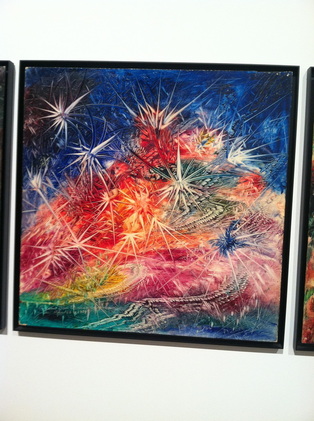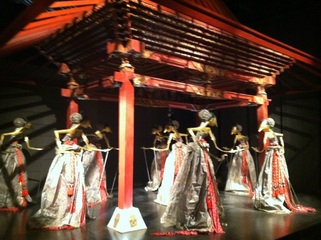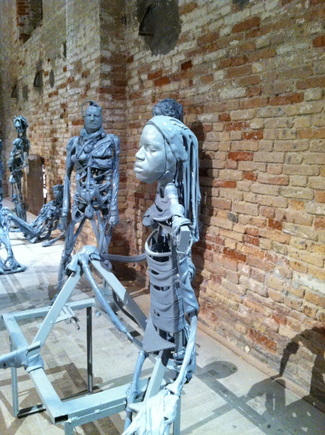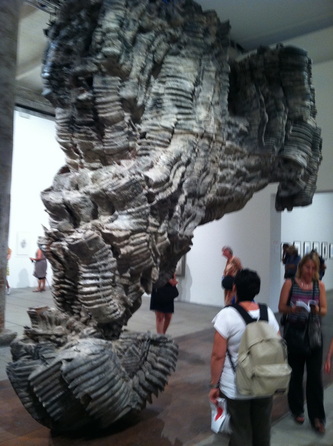
1.
Eugene Von Bruenchenhein "Untitled" No. 704 is a small to medium sized oil on canvas. He creates paintings that have a chaotic apocalyptic appearance. He uses rich vibrant colors that have no apparent color scheme which could emphasize its chaotic appeal. It looks as if fireworks are shooting high in the sky. Bruenchenhein makes dynamic lines with these "fireworks" even though the overall painting is considered to be abstract. Bruenchenhein in fact has a unique style he uses to his paintings simply by using his finger as a paint brush to create wave like motions in his art.
Eugene Von Bruenchenhein "Untitled" No. 704 is a small to medium sized oil on canvas. He creates paintings that have a chaotic apocalyptic appearance. He uses rich vibrant colors that have no apparent color scheme which could emphasize its chaotic appeal. It looks as if fireworks are shooting high in the sky. Bruenchenhein makes dynamic lines with these "fireworks" even though the overall painting is considered to be abstract. Bruenchenhein in fact has a unique style he uses to his paintings simply by using his finger as a paint brush to create wave like motions in his art.

2.
Sri Astari's Pendopo: Dancing the Wild Seas is found in the Indonesia Pavilion by Albert Yonathan Setiawan. He creates seven bedoyo dancers which are made of leather (upper body), steel mesh (garments), and wood (majority of the figure overall).The figurines are life sized with exaggerated facial and physical appearances with their long pointy noses and skinny straight body. Its apparent that it could be a traditional ceremony where the figurines are all positioned in the same way to indicate dancing or a sense of motion. There's a symmetrical balance between figurines on each opposing side, facing one another concludes to my theory of the art being a spiritual/traditional organized dance.
Sri Astari's Pendopo: Dancing the Wild Seas is found in the Indonesia Pavilion by Albert Yonathan Setiawan. He creates seven bedoyo dancers which are made of leather (upper body), steel mesh (garments), and wood (majority of the figure overall).The figurines are life sized with exaggerated facial and physical appearances with their long pointy noses and skinny straight body. Its apparent that it could be a traditional ceremony where the figurines are all positioned in the same way to indicate dancing or a sense of motion. There's a symmetrical balance between figurines on each opposing side, facing one another concludes to my theory of the art being a spiritual/traditional organized dance.

3.
Venetians by Pawel Althamer constructs 90 life size abstracted human sculptures made from his father's plastic manufacturing company. He then cast the hands and faces of locals and used plastic ribbons and steel to form their bodies. It is quite a surreal piece of artwork to have realistic faces but have everything else be abstract. Althamer explains about why he choose the weird physical appearances because "it is a major achievement to realize that the body is only a vehicle for the soul." Each figure looks like they are trying to figure themselves out like they don't know what to do next Each figurine has many negative spaces due to their decaying, ribbon like bodies. In fact, the plastic ribbons used for the bodies keeps the viewers eyes moving along as it intertwines with the body which leads up to the head and down to the feet.
Venetians by Pawel Althamer constructs 90 life size abstracted human sculptures made from his father's plastic manufacturing company. He then cast the hands and faces of locals and used plastic ribbons and steel to form their bodies. It is quite a surreal piece of artwork to have realistic faces but have everything else be abstract. Althamer explains about why he choose the weird physical appearances because "it is a major achievement to realize that the body is only a vehicle for the soul." Each figure looks like they are trying to figure themselves out like they don't know what to do next Each figurine has many negative spaces due to their decaying, ribbon like bodies. In fact, the plastic ribbons used for the bodies keeps the viewers eyes moving along as it intertwines with the body which leads up to the head and down to the feet.

4.
Alfredo Jaar: Venezia, Venezia (Pavilion of Chile) is a replica of the Giardini venue with all the 28 national pavilions. It took one year to create the 160 scale model. Every three minutes it will rise and fall in the dark, greenish water. Jaar creates these perfectly miniature architectural pavilions that are quite accurate to their original pavilions. Jarr states is a utopia that has been left behind so when it emerges to the surface its like a "ghost from history." He wants the audience to rethink the model of the Biennale. You can move around the three-dimensional piece and find a different perspective at every angle. But you have to move quick though because in no time it'll submerge back into the water.
Alfredo Jaar: Venezia, Venezia (Pavilion of Chile) is a replica of the Giardini venue with all the 28 national pavilions. It took one year to create the 160 scale model. Every three minutes it will rise and fall in the dark, greenish water. Jaar creates these perfectly miniature architectural pavilions that are quite accurate to their original pavilions. Jarr states is a utopia that has been left behind so when it emerges to the surface its like a "ghost from history." He wants the audience to rethink the model of the Biennale. You can move around the three-dimensional piece and find a different perspective at every angle. But you have to move quick though because in no time it'll submerge back into the water.

5.
Roberto Cuoghi conducts a massive bizarre sculpture called Belinda (2013) that is 450 x 400 x 315 cm. What is impressive about this piece is that it was made from a 3D printer then loaded down with stone dust. Despite its real consistency it still looks realistic rock in the viewers eyes. Cuoghi uses a combination of both organic (the overall shape) and geometric shapes (the little horizontal lines) in his sculpture. You can see how the whole entire sculpture is textured. It looks as if it came from a cave, ancient artifact, or even from outer space.
Roberto Cuoghi conducts a massive bizarre sculpture called Belinda (2013) that is 450 x 400 x 315 cm. What is impressive about this piece is that it was made from a 3D printer then loaded down with stone dust. Despite its real consistency it still looks realistic rock in the viewers eyes. Cuoghi uses a combination of both organic (the overall shape) and geometric shapes (the little horizontal lines) in his sculpture. You can see how the whole entire sculpture is textured. It looks as if it came from a cave, ancient artifact, or even from outer space.
 RSS Feed
RSS Feed